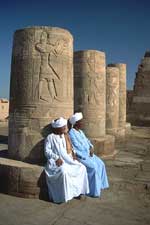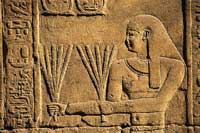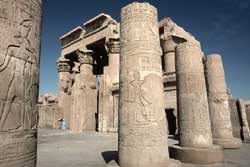|
The Temple of Kom Ombo
 While
the stone differs from that of all the other temples perhaps
because it was covered with sand for so long, the outstanding
feature of the Kom Ombo Temple is the unusual, even unique,
ground plan, the result of the unification of two adjacent
temples, each dedicated to a distinct divinity: the
crocodile-headed Sobek, god of fertility and creator of the
world, and Haroeris or the ancient falcon-headed Horus, the
solar war god. While
the stone differs from that of all the other temples perhaps
because it was covered with sand for so long, the outstanding
feature of the Kom Ombo Temple is the unusual, even unique,
ground plan, the result of the unification of two adjacent
temples, each dedicated to a distinct divinity: the
crocodile-headed Sobek, god of fertility and creator of the
world, and Haroeris or the ancient falcon-headed Horus, the
solar war god.
This was why the temple was called both "House of the Crocodile"
and "Castle of the Falcon". An imaginary line divides the temple
longitudinally into two parts, each with its entrance, hypostyle
halls, chapels, etc. The right part of the temple was
consecrated to Sobek, the left to Haroeris, whose winged disk
that protects from all evils is depicted over all the entrance
portals. This temple, too, was the work of the Ptolemies who
built it on the site of a much older and smaller sanctuary of
which little remains.
 The
actual temple was started by Ptolemy VI Philometor in the early
second century BC. Ptolemy XIII built the outer and inner
hypostyle halls. The outer enclosure wall and part of the court
were built by Augustus sometime after 30 BC, and are mostly
gone. There are also tombs from the Old Kingdom in the vicinity
of Kom-Ombo village. The
actual temple was started by Ptolemy VI Philometor in the early
second century BC. Ptolemy XIII built the outer and inner
hypostyle halls. The outer enclosure wall and part of the court
were built by Augustus sometime after 30 BC, and are mostly
gone. There are also tombs from the Old Kingdom in the vicinity
of Kom-Ombo village.
In ancient times, sacred crocodiles basked in the sun on the
river bank near here. The Temple was used to store mummified
crocodiles form the nearby animal necropolis and a few
sarcophagi The Temple has scant remains, due first to the
changing Nile, then the Copts who once used it as a church, and
finally by builders who used the stones for new buildings.
In the southwest corner of the pronaos is the one column that
does not echo the duality of the temples. Here, there are scenes
depicting purification of the King, his coronation and his
consecration of the Temple. The ceiling has astronomical images.
 The hypostyle hall has papyrus capitals on the columns. The hypostyle hall has papyrus capitals on the columns.
Here,
there is an inventory of the scared places of Egypt, the gods of
the main towns and the local and national festivals.
In the anti chamber, there are scenes depicting the goddess
Seshat launching the building of the temple, followed by a scene
of the completed temple with the king throwing natron in a
purification ceremony.
Statues to the gods and the builders of the temple once occupied
the net room just before the sanctuaries. The ceiling of the
pure place to the north still remains with an image of Nut.
There is little left of the sanctuaries
The pervasive presence of Nile, where the feluccas silently
glide over the water, and of the deep green fields which
accentuate the blue of the sky, accompany your visit to Kom Ombo |